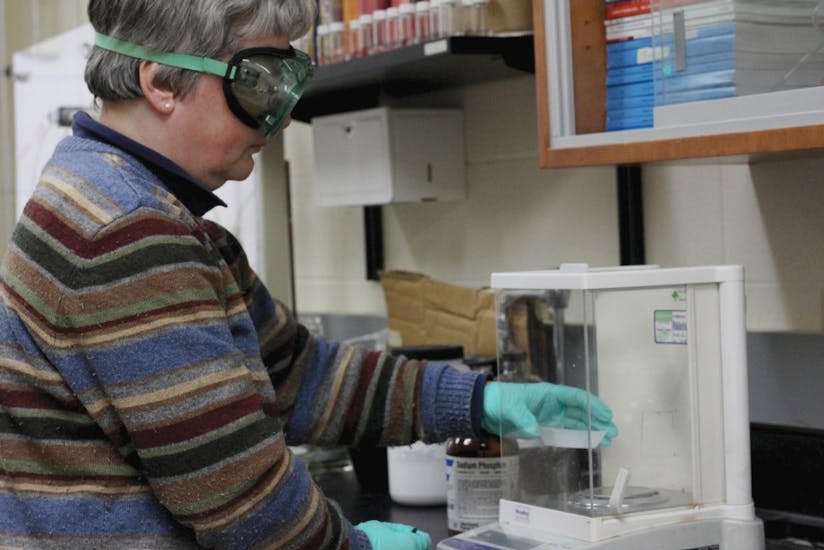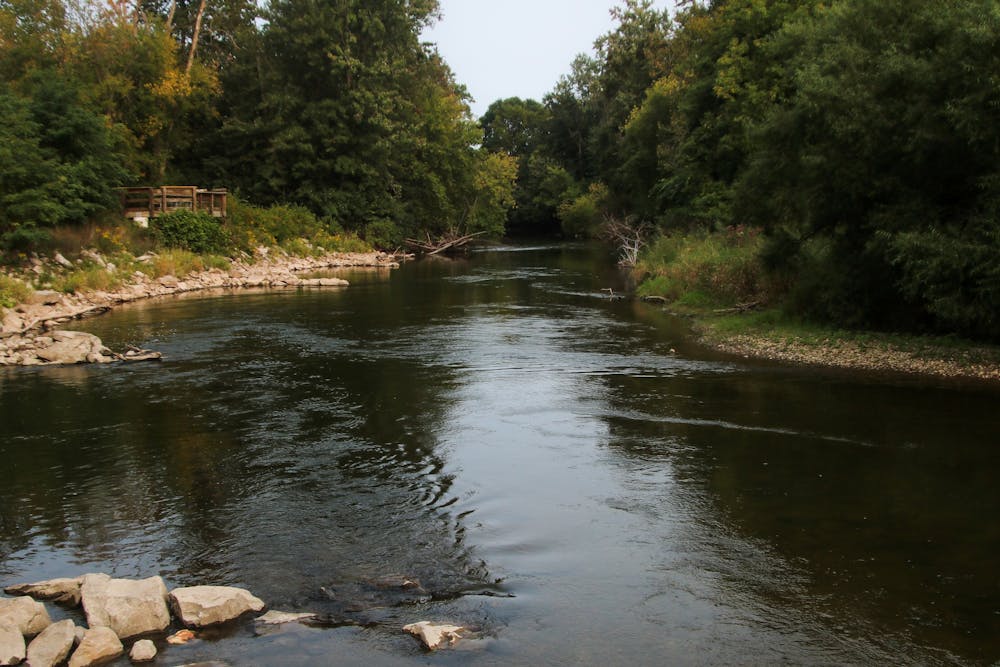CMU water research team making strides
A research team at Central Michigan University is working on developing a material that will purify water. The team is set to present their findings so far May 9-10 at Michigan’s 29th Annual Automotive Research Center Program Review at the University of Michigan Engineering Department in Ann Arbor.

Professor Anja Mueller measures chemicals in her lab in this 2015 file photo.
The team is comprised of faculty members Itzel Marquez, Anja Mueller and Bradley Fahlman, as well as three graduate students, two undergraduate students and one post-doctoral student.
Working off a grant given by the United States Army, the team has been tasked to create a water purification material that is more efficient than current techniques. Aimed to be implemented in the Army, Mueller and Marquez said it is their goal for their system to be:
- Portable
- Porous (able to let water through)
- Of a large surface area
- Strong enough to withstand water flow
“The Army is requiring highly portable, stand-alone treatment systems,” Marquez said. “I think that is a great advantage, not only for military operations, that would be a great advantage for many different situations.”
“We are mixing and matching to get all of these properties right,” Mueller said.
While current water purification systems meet the Environmental Protection Agency’s (EPA) requirements for clean drinking water, Marquez and Mueller said they do so at the bare minimum.
According to EPA.gov, the "EPA sets legal limits for over 90 contaminants in drinking water," including microorganisms, disinfectants and radionuclides. Depending on the contaminant, each standard is different.
The two said they hope their material is less expensive and more efficient than these current systems.
Marquez, Mueller and Fahlman said the research team’s main focus is getting the toxic compounds ammonia and arsenate out of drinking water. However, this presents a challenge.
Dr. Marquez explained how they are creating the material to destroy these toxic compounds. But if there are other ions in the water -- ions that we need to remain healthy and that share physical or chemical characteristics with ammonia or arsenate -- those ions could unintentionally be removed, too.
According to a United States Geological Survey, calcium and magnesium are some examples of good ions in drinking water.
Speaking on current water purification systems, Marquez said: “That’s what is generally done. You remove all of the ions and then you end up adding ions [back in], and that makes it inefficient. So we’re trying to increase efficiencies of those processes.”
Dr. Fahlman’s area of interest on the project is two-part: Providing support for the material to withstand water flow and destroying the toxic compounds once they are removed from the water -- a process referred to as photocatalysis.
Support will be provided by incorporating carbon-based sheets of material into the device.
Photocatalysis, or catalysis, involves “forcing contaminants to interact with light, where they will break down into smaller pieces that are no longer toxic,” Marquez explained.
“If we can stick something in the membrane that can kill and destroy that [toxic] material at the same time when we catch it, we would, first of all, increase how much [toxic material] we catch, and second of all, we don’t have to deal with that toxic [compound] we are getting out,” Mueller said.
Mueller and Marquez cited the Flint water crisis as a problem that people in the area might be able to relate to, but there are also issues across the country and even across the globe.
“It is a world-wide problem,” Marquez said. “It doesn’t matter if you live in highly industrialized or high-income countries like the U.S. You have crisis, like the one in Flint, crisis like the one in California and Arizona where they’re hit by severe drought. … Climate change is not letting it get better anytime soon.”
In Flint, a city located roughly an hour and half south of Mount Pleasant, Mueller said water regulation was loosened when it’s population dropped below 100,000. With looser regulations, water in Flint was not tested by treatment facilities as much, and issues of water contaminated with lead became an emergency crisis.
“[It was] completely unethical, and yet completely legal,” Mueller said.
“Access to clean, safe water is considered a human right,” Marquez agreed.
Mueller and Marquez’s advice to Central Michigan University students is to get involved with research teams if it sounds like something that interests them.
“I have taken freshman, and they sometimes work all the way through their senior year,” Mueller said. “It’s a perfect way of learning in a completely different way.”

Priyalatha Kirisenage, a graduate student working towards a master's in chemistry, is also a part of the research team. She said the work is hard, but the researchers are nice and have a lot of experience in their field.
“I’m enjoying the work,” Kirisenage said.
“There are plenty of opportunities, so talk to your faculty and see what they are doing when they’re not in class, because there’s a lot of great things going on,” Marquez said.
For more in-depth information on their studies, check out their published scientific journal.







